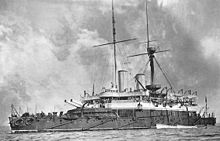Utopia (ship)
|
Drawing of the Downfall by Georgina Smith (1891)
|
||||||||||||||||||||
|
||||||||||||||||||||
|
||||||||||||||||||||
|
||||||||||||||||||||
|
||||||||||||||||||||
|
||||||||||||||||||||
The Utopia was a passenger ship of the British shipping company Anchor Line put into service in 1874. It was built for transatlantic traffic and carried passengers , freight and mail from England to New York and later to the Mediterranean . On March 17, 1891, the Utopia collided in the port of Gibraltar with a British warship , the bow of which slashed the passenger ship and let it sink within a few minutes. 564 people were killed. The sinking of Utopia is the greatest calamity in the history of the Anchor Line.
The ship
The Utopia was built in 1874 by the Scottish shipbuilding yard Robert Duncan and Company on the Clyde for the Anchor Line, a British steamship company based in Glasgow , founded in 1856, and launched there on February 14, 1874. Their hull was made of iron . It had a chimney, a propeller and three masts . She had two sister ships , the Elysia (1873) and the Alsatia (1876).
The Utopia was designed to accommodate 120 passengers in first, 60 in second and 600 in third class. In the course of her years of service she was deployed successively on different routes. On May 23, 1874, the Utopia set off on its maiden voyage from Glasgow via Moville to New York. On this route she made twelve crossings before she drove from Glasgow to Bombay from September 1875 . From April 30, 1876, she served the Glasgow – New York route, on which she completed 40 Atlantic crossings. From February 1882, the Utopia was in the shipping company's Mediterranean service, heading for the ports of Messina , Naples and Trieste . From now on it mainly transported emigrants to the USA .
1890-1891 the ship was rebuilt and equipped with triple expansion steam engines. The passenger accommodations were also converted: the ship now had space for 45 first-class passengers and 900 third-class passengers. The second class was abolished.
Downfall

On Wednesday, 25 February 1891, the left Utopia under the command of Captain John McKeague Trieste with the aim of New York and stops in Naples and Gibraltar . On board were three first class passengers, 815 third class passengers (mainly Italian emigrants), 59 crew members and three stowaways who were only discovered after casting off. A total of 880 people made this crossing, including 85 women and 67 children.
On the afternoon of March 17, 1891, the steamer entered the port of Gibraltar in stormy weather and the resulting poor visibility, where parts of the English Mediterranean fleet were at the time . McKeague steered his ship to its usual berth until he noticed that the two warships HMS Anson and HMS Rodney were already there. McKeague later testified that he was briefly blinded by the Anson's search light . He also thought the distance between the two ships was greater than it actually was and wanted to steer the Utopia past the bow of the liner. Squalls and lashing waves recorded the Utopia at 18:36 and left them on the then on large warships still usual Rammbug of Anson bounce. This tore a five meter wide hole below the waterline in the stern of the Utopia . The ship began to sink quickly. On board, panic broke out among the passengers, who immediately rushed to the lifeboats . The lights went out after a short time and many people jumped overboard.
Captain McKeague initially tried to put the ship aground, but the engines failed almost immediately. He ordered the boat to be disembarked, but the Utopia suddenly tilted 70 degrees to port , which destroyed the lifeboats on that side. Hundreds were trapped in the ship, with many more clinging to the starboard side. 20 minutes after the collision, the Utopia sank to the bottom of the 17 meter deep harbor basin. Ships of the Royal Navy came to the aid of the shipwrecked immediately, but could not get close enough because of the rough seas and stormy weather. Of the 880 people on board, 318 were finally rescued: 290 third-class passengers, two first-class passengers, 23 crew members and the three stowaways. The remaining 562 passengers and crew members were killed. In addition, two men from the armored cruiser HMS Immortalité who wanted to help rescue the castaways drowned . The first Utopia victims, 28 adults and three children, were buried in Gibraltar on March 20th. Captain McKeague, who survived, was arrested but released the same day on bail .
Shortly after the accident, divers were sent to the wreck , who reported "hundreds of corpses" that were "crammed so closely together that they could hardly be separated from each other". The masts and the chimney towered above the surface of the water. The wreck was illuminated to avoid further accidents, but the steamer Primula collided with it when entering port. On March 23, 1891, under the chairmanship of the port master of Gibraltar, the official investigation into the accident began. Captain McKeague was blamed for the accident because of serious errors in assessing the situation. In July 1892 the wreck of the passenger steamer was recovered and brought back to the shipyard in Glasgow, where it rusted for eight years. In April 1900 it was sold to the demolition company Thomas W. Ward Shipbreakers Ltd. sold, which the Utopia then scrapped .


